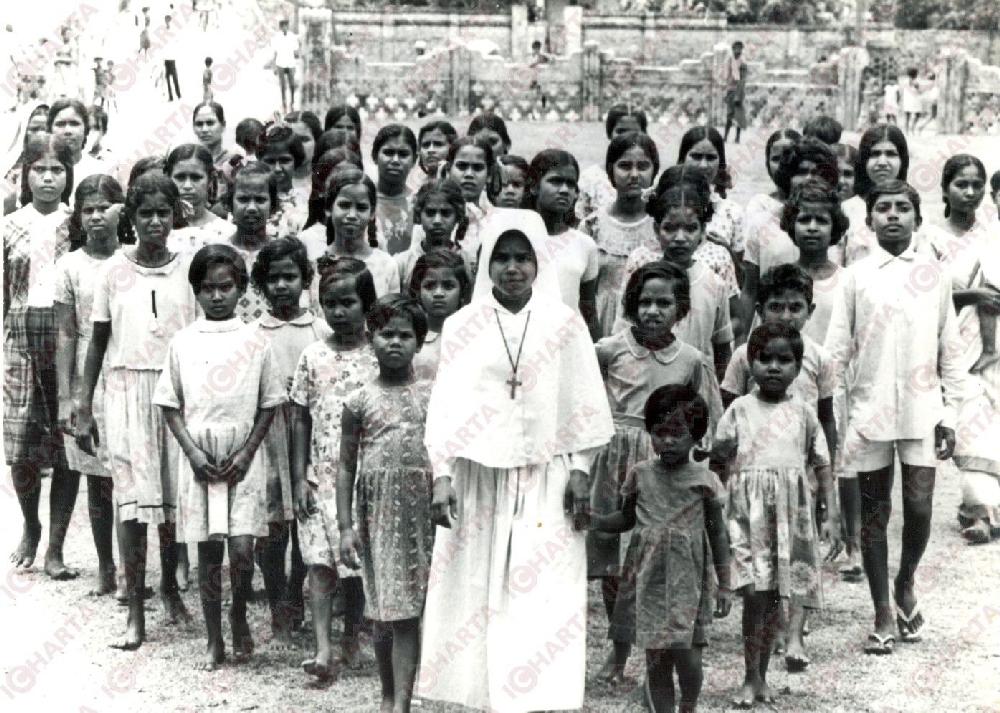
Third Indo-Pakistani War: Bangladesh Genocide

Figure 1.--This 1971 press photograph shows Sister Vacinta D'Cruz which children she saved during the Bangladesh Genocide. We do not have the press caption, but we think these are Bebgali Hindu children who Sister Vacinta helped disguise as Christians.
|
|
The Pakistani Army proved nothing short of savage in its treatment of civilians. Many West Pakistanis saw the Bengalis as trechrous because of their support for the Awami League and India. The Army commited horendous attrocities as part of its security operations. Whole villages and their people were destroyed. Hindus became special targets because Indiaas aiding the resistance. The exact death total will never be known, but is believd hundreds of thousands of victims died at the hands of the Pakistani Army. The Pakistani actions is classified by many academic sources as the Banladesh Genocide, but some sources object to the use of the term. It began with the Pakistani Army launching Operation Searchlight (March 26). [Spencer, p. 63.] This began with the Pakistani Army's crackdown in East Pakistan. During the ebsuing 9-month-long Bangladesh independence struggle, members the Pakistani Army and allied Islamist militias (Jamaat-e-Islami, Bihari and Bengali Razakar, and al-Badr militias) killed in unbelieveable numbers. Bengali sources claim that some 3 million Bengalis were killed. [Alston, p. 40.]. There is no precise accounting and independent sources
estimate the killing as more like 0.3-0.5 million people. [Dummett and Hiro, p. 216.] We have not definitive information, but find it difficult to believe that without a NAZI-like industril killing infrastructure and a supportive population that 3 million people could have been killed in 9 months. The Benghalis have attempted to collect information. ["Bangladesh sets up ..."] Army personnel and the Islanic militants are believed to have raped 0.2-0.3 million women. [Roychowdhury] This was not an uncontrolled rampage, but a systematic campaign described as 'genocidal rape'. [Sharlach, pp. 92–93.] As strange as it may seem, the raping of Bengali women was justified by Islamic clerics who declared them to be 'gonimoter maal' (public property). [D'Costa, p. 108.] In addition to the Pakistani killing and raping, there was also other ethnic-religious violence. The most serious was between Bengalis and Urdu-speaking Biharis. [Saikia, p. 3.] The Biharis were attacked by Muslim Bengali mobs and militias. [Khan and Rahman, p. 101.] The resulting deaths are poorly documented and estimates range from small numbers to as many as 0.5 million Biharis.
Sources
Alston, Margaret (2015). Women and Climate Change in Bangladesh (Routledge: 2015).
D'Costa, Bina (2010). Nationbuilding, Gender and War Crimes in South Asia (Routledge: 2010).
Khan, Borhan Uddin and Muhammad Mahbubur Rahman (2010) in Rainer Hofmann and Ugo Caruso, ed. Minority Rights in South Asia (Peter Lang: 2010)..
Roychowdhury, Adrija. "Birth of Bangladesh: When raped women and war babies paid the price of a new nation, Indian Express ( New Delhi) (December 19, 2016).
Saikia, Yasmin (2011). Women, War, and the Making of Bangladesh: Remembering 1971 (Duke University Press:
Spencer, Philip. Genocide Since 1945. (Routledge: 2012).
Sharlach, Lisa (2000). "Rape as Genocide: Bangladesh, the Former Yugoslavia, and Rwanda". New Political Science Vol. I, No. 22, pp. 89-102.
"Bangladesh sets up war crimes court – Central & South Asia" Al Jazeera (March 25, 2010).
CIH

Navigate the Children in History Website:
[Return to Main Third Indian-Pakistani conflict page]
[Return to Main Indian-Pakistani conflict page]
[Return to Main Indian history page]
[Return to Main Pakistani history page]
[Return to Main mass killing and genocide page]
[Return to Main 20th century page]
[About Us]
[Introduction]
[Biographies]
[Chronology]
[Climatology]
[Clothing]
[Disease and Health]
[Economics]
[Freedom]
[Geography]
[History]
[Human Nature]
[Ideology]
[Law]
[Nationalism]
[Presidents]
[Religion]
[Royalty]
[Science]
[Social Class]
[Bibliographies]
[Contributions]
[FAQs]
[Glossaries]
[Images]
[Links]
[Registration]
[Tools]
[Children in History Home]
Created: 7:12 PM 11/18/2017
Last updated: 10:43 PM 11/18/2017



